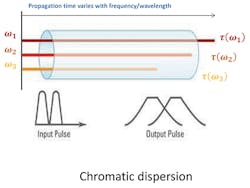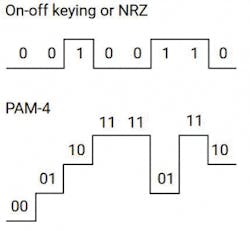As we learned in last month’s column, chromatic dispersion (CD) can limit the transmission rate and distance an optical signal can be transmitted. (See "A Colorful Problem Chromatic Dispersion Challenges", ISE magazine, September 2018). As transmission rates continue to increase, optical dispersion becomes the number one problem which must be addressed when migrating to higher data rates. (See Figure 1.)
Figure 1. Chromatic dispersion is the single largest impairment to high speed transmission. (Courtesy Ciena)
Since we know what the problem is, what are our options to resolve? New systems are incorporating a combination of coherent detection, forward error correction, and a variety of advanced modulation formats, to mitigate dispersion challenges while increasing the bandwidth of the systems.
This involves how we encode information, modulate the laser source and receive the signal while maintaining high bit error rates of 10-12. Historically the use of simple on-off keying (OOK) and direct detection methods have been sufficient at data rates up to 10 Gigabits per second. At data rates of 100 Gb/s and higher, advanced modulation formats using phase shift keying (PSK) are required to maximize the bandwidth while transmitting the least amounts of bits.
PSK extends the reach and data capacity by conveying data by modulating the phase of the optical carrier by using a number of phases with each assigned a pattern of binary digits. The receiver’s demodulator determines the phase of the received signal and maps it back to the symbol it represents, therefore recovering the original data. This requires the receiver to compare the phase of the received signal to a reference signal generated by a local laser oscillator. Because of this, the system is called coherent.
You can see in Figure 2 how using PSK technology can increase the amount of information sent within the same time frame. OOK is sufficient for most 10 Gb/s systems. 100 Gb/s requires using one of the PSK formats.
Figure 2. New modulation formats transmit greater information. (Courtesy EXFO)
Differential phase shift keying (DPSK) changes the input signal by a specified amount, and the receiver’s demodulator then determines the changes in the phase of the received signal.
Taking the concept of PSK a stage further is quadrature phase shift keying (QPSK). With QPSK, the optical carrier undergoes 4 changes in phase, and can represent 2 bits of data per symbol instead of 1, effectively doubling the bandwidth.
Another format, dual polarization QPSK (DP-QPSK) enables the transmission of even more channels by supporting a signal in 2 polarizations.
Combined with the use of coherent detection transmission, impairments such as chromatic and polarization mode dispersion can be mitigated electronically when the optical signal is converted into the electronic domain. The use of forward error correction (FEC) uses a technique at the transmitter that allows for nearly perfect data transmission by adding redundant data to messages. This allows the receiver to detect and correct errors, resulting in a lower receiver-end optical signal to noise ratio (OSNR) even though it requires a larger overhead
in the signal.
Today we are witnessing major changes in transmission technology to address next-generation data rates over 100 gigabits per second (Gb/s). Given that, what is required of your physical plant to handle these changes? The current challenge is to identify the amount of dispersion in your system and work with your transmission equipment vendor to determine the best and most cost-effective solution for your needs.
About the Author



